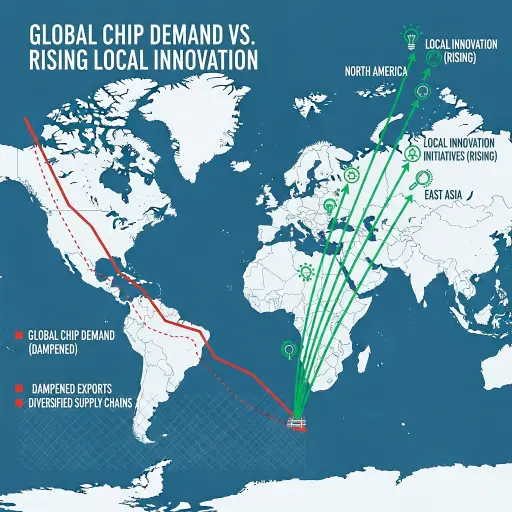The gloves come off in the commodity exchange of policy and silicon. In the current theatre, the United States leans over the table with export controls on chipmaking equipment, and China leans back with efficiency plots, synthetic biology of supply chains, and a readiness to re-architect its own tech stack. The dynamic has a name in the theory books and a counterpoint in boardrooms: weaponized interdependence. It is not simply about restricting access; it is about weaponizing the very weave of interconnection—the shared feedstocks, the shared ecosystems, the shared ambitions that propel global innovation.
To the untrained eye, it may look like a stumble in a well-oiled machine. Applied Materials, a bellwether of fabrication equipment and a proxy for the health of the silicon economy, signaling caution or constraint, signals more than a company alert. It signals a policy posture: when the central nervous system of modern industry—the ability to create, refine, and deploy advanced chips—comes under friction, the entire operating system of global tech recalibrates. The immediate effect is a dampening of the race’s slope in the rival’s direction. But the longer arc, when viewed through systems theory, is not a mere line but a variable. The friction compresses some futures and expands others, injecting variance into China’s local production pathways.
Weaponized interdependence rests on a simple premise: the more interwoven two economies become through trade, investment, and shared technology, the more leverage one can exert over the other. The United States leverages export controls to throttle compute to China, the engine room of a large part of the world’s digital economy. The intent is straightforward: slow a rival’s innovation curve, hinder strategic capabilities, and tilt competitive dynamics toward incumbents and allies. Yet complexity rarely yields linear outputs. In a classical systems view, throttling one node generates a spectrum of responses across the network: firms pivot to substitute technologies, researchers seek domestic or partner-country ecosystems, and suppliers reconfigure architectures to preserve critical capabilities.
The paradox is precise: an action designed to flatten a rival’s progress can instead widen variance in outcomes across regions. Some teams accelerate domestic and allied ecosystems, investing in domestic capacities, and thriving on accelerated experimentation in open or semi-closed loops. Others sprint toward self-contained stacks, favoring localized standards, and building parallel innovation streams with different institutional incentives and risk tolerances. The result is not a single deceleration but a bifurcation of global technology architecture: twin tracks of capability with divergent standards, tools, and supply chains coexisting, each resilient in its own right, but increasingly incompatible.
This is not mere geopolitics; it is risk management at scale. For investors, it reframes portfolio calculus. Exposure to a singular global supply chain—once the default assumption—now carries a layered risk: policy pivot risk, supplier concentration risk, and the contagion of technology sovereignty. The prudent response is to view suppliers, customers, and competitors as a single, dynamic network with multiple, shifting equilibria. Diversification becomes not just geography but architecture: diversification across process nodes, dependency profiles, and ecosystem ecosystems. The financial markets, in turn, price-in these contingencies with sharper premiums on resilience, on transparent roadmaps, and on credible localization strategies.
But the narrative is not entirely deterministic. The boundaried friction may also accelerate innovation in places spared from direct control regimes. If China and its allies rewrite the architecture of their systems—moving from a dependency-dense supply chain to a modular, multi-pipe, multi-sourced model—then the global tech stack might adopt greater redundancy and adaptability. The societal payoff, in the long run, is a more robust, collision-resistant infrastructure. The price might be higher upfront—compliance costs, ecosystem recalibration, and potential friction with global partners—but the upside is resilience and a more diverse, hence less brittle, innovation ecosystem.
For policymakers, the lesson is threefold. First, recognize that weaponized interdependence changes not only what is scarce but who can adapt to scarcity. Second, anticipate a future in which standardization becomes a negotiable variable, not a fixed endpoint. Third, couple export controls with transparent, time-bound roadmaps that invite early-stage collaboration and predictable de-risking for global partners. Without a credible path for collaboration, the policy may achieve short-term strategic gains at the expense of long-run global productivity and shared welfare.
From a corporate vantage, the optimal posture blends hedging with opportunism. Hedge through diversified supplier bases, joint ventures, and active participation in alternate standards bodies. Opportunism through accelerated investments in domestic fabs, domestic R&D, and bilateral partnerships that insulate core capabilities from geopolitical windstorms. In short, secure the architecture without exhausting the system.
This is where the thread of entropy-aware writing ties back to the field that inspired it. The efficacy of export controls hinges on how well the actors anticipate and manage risk across a distributed information channel. A policy that slows one path may inadvertently intensify exploration in others. The resulting landscape—more diverse, more modular, more local in intent but global in effect—could be messier, yet more robust. The paradox, perhaps finally, is elegant: constraint designed to slow growth ultimately becomes a catalyst for a broader, more resilient innovation network.
Endnote: The Redundancy–Entropy equilibrium still governs the conversation. If the industry’s social memory retains a single lesson—“throttle now, pay later”—the system may learn to tolerate longer horizons of policy uncertainty. If, instead, it internalizes a multilateral, modular frame, it will reward those who design for redundancy and D-S resilience. In either case, the future of the global tech stack will be shaped not merely by who has the most chips, but by who has the best architecture to weather the next shock.
And so the narrative closes with a one-line distillation, in the spirit of recursive summarization: export controls may slow a rival, but they also sculpt a more variegated, less predictable global technology ecosystem. The result is not a single race, but a multi-track marathon, where resilience and adaptability win over a mere sprint to supremacy.
Sources
Policy memos, market disclosures, Applied Materials' statements, and academic treatments of weaponized interdependence and supply chain fragility.
